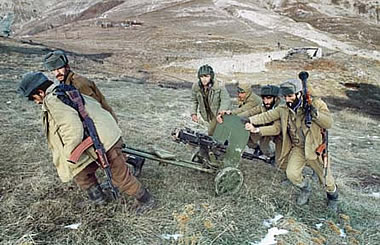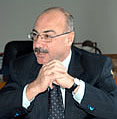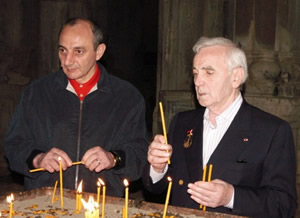History of Karabakh (part 5)
Armenians withstand Azeri attacks
 Armenian fighters move in to secure the Lachin corridor.
Armenian fighters move in to secure the Lachin corridor.
The summer of 1992 was crucial. Despite great losses, the Armenians were able to withstand furious attacks on all front lines. Azeri military widely used bomber forces, in which Russian and Ukrainian mercenary pilots played the major role. Dropping forbidden cluster bombs on the Armenian villages became a common practice. In the fall of 1992, the Azeri troops tried to regain control over Lachin, but were hurled back. Following the Armenian counterattack, the military operations moved to the Kubatli region of Azerbaijan. However, most of the Mardakert region was still under the Azeri control.
Monte
 Monte Melkonian (Avo), fell in battle in June 1993.
Monte Melkonian (Avo), fell in battle in June 1993.
Another Armenian counteroffensive took place in February 1993. After a number of fierce battles, the Armenian fighters regained control over the Sarsang Reservoir. In March, the NKR Army began the Kelbajar operation, which succeeded in April. The Azeri forces responded with desperate attacks from the East, but the defense of the Martuni region was well organized by Monte, whose exceptional courage and devotion to the liberation of Artsakh made him the legendary Armenian hero.
The liberation of the city of Mardakert on June 27, 1993 was a turning point. Afterwards, the elimination of mighty weapon emplacements in the city of Aghdam became an urgent objective. At the very beginning of the conflict, Aghdam was converted into a dangerous base, packed with ammunition and weapons. On July 23, Aghdam was taken, which allowed the inhabitants of Stepanakert and Askeran to restore normal course of life after 18 months of non-stop bombing.
Armenians advance
In August of 1993, the major operations took place in the Hadrout region, which was finally liberated by the advancing Armenian forces on August 26. By the end of August, Djebrail and Kubatli regions also fell under the Armenian control. The Armenian victories forced the Azeri military leadership to call off their troops, and a lull was established for the next 45 days. Then, Azerbaijan resumed the military operations trying to recapture the strong points in the Hadrout region. However, the Azeri forces suffered a new repulse. Continuing their offensive, the Armenians also took the Zanguelan region.
In February 1994, the Azeri troops made their last attempt to break the Armenian positions in northeast of the NKR, but were defeated again. In April, the final lull was established after the Armenian fighters gained a number of important commanding heights in the Mardakert region. To this day, the NKR Army continues to control most of Nagorno-Karabakh as well as a buffer area comprising neighboring regions in the Azerbaijan Republic.
A cease-fire
A cease-fire brokered by Russia and other countries of the CIS was signed in Bishkek, Kirghizia on May 5, 1994. The truce was confirmed on May 16 in Moscow during the meeting of the Defense Ministers of Azerbaijan, Armenia and the NKR. Since then, the issue has become the focus of mediation efforts of OSCE (Organization for Security and Cooperation in Europe). A special group, called “Minsk group” was formed by OSCE to work out principles of settling the conflict.
Ghukassian elected President of the NKR
 Arkady Ghukassian
Arkady Ghukassian
In April of 1995, the first parliamentary elections took place in Artsakh in new and peaceful conditions, to form a new 33-seat legislature. In November of 1996, the first nation-wide presidential elections were held in Artsakh, and Robert Kocharyan was elected President of the NKR to a five-year term. However, as Kocharyan accepted Levon Ter-Petrossian‘s offer to become Prime Minister of Armenia in March 1997, new presidential elections were held in Artsakh in September 1997. Arkady Ghukassian, former Minister of Foreign Affairs of the NKR, was elected President with 89% of the vote.
Unrest in Armenia and Karabakh
Following the internal crisis in 1999 Armenia, where a terrorist attack took lives of eight high officials, including Prime Minister Vazgen Sarkisian and Speaker Karen Demirchian, an assassination attempt on President Ghukassian took place in Stepanakert, some 5 months later. The President was seriously wounded. Samvel Babayan, former Minister of Defense of NKR, was charged of masterminding the attempt, and arrested among 16 others. He was sentenced to 14 years in prison, but released 4 years later.
Bako Sahakian
 Newly elected Bako Sahakian holds the certificate of election, on September 5, 2007.
Newly elected Bako Sahakian holds the certificate of election, on September 5, 2007.
The new presidential elections in Karabakh took place in summer 2007. Bako Sahakian, former Deputy Commander of the Karabakh Army, and then Minister of Interior, won the elections with 85 percent of the votes. He pledged to seek full independence of Nagorno-Karabakh.










